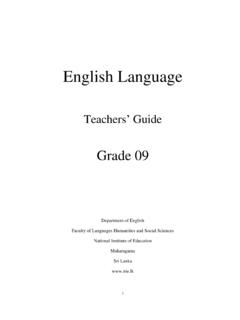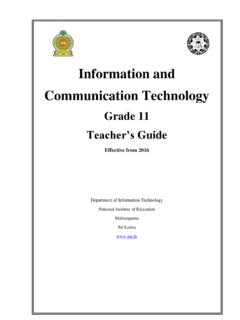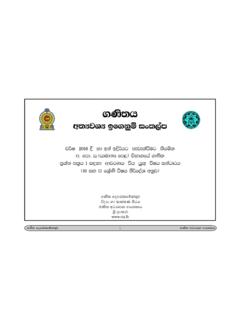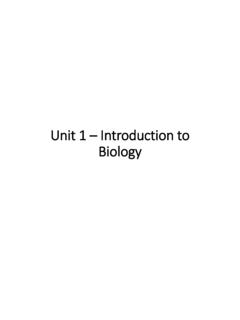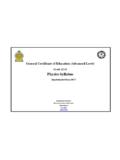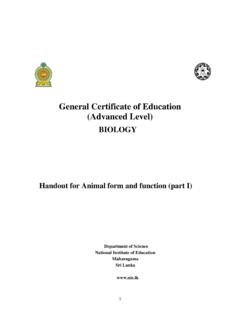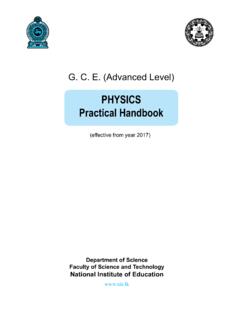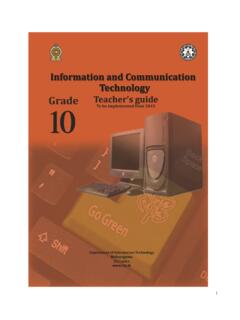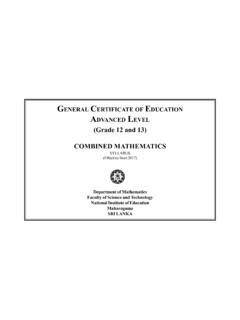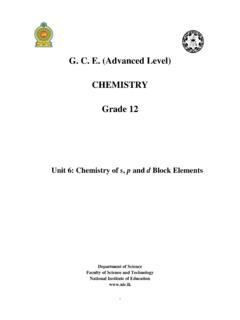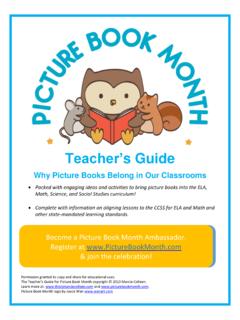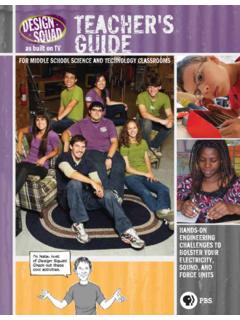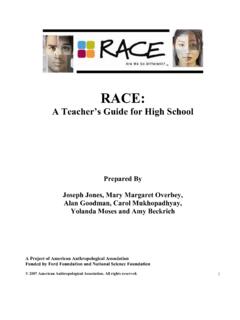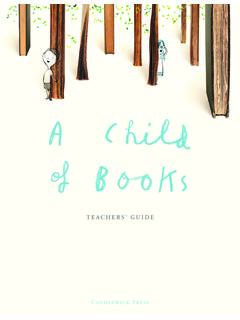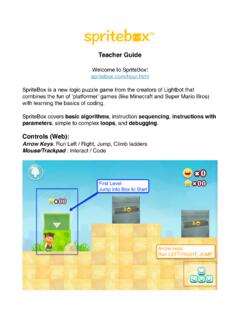Transcription of Teachers’ Guide - NIE
1 IWestern MusicTeachers GuideGrade 10(Implemented from 2015)Department of Aesthetic EducationNational Institute of EducationMaharagamaSri MusicTeachers GuideGrade 10(Implemented from 2015)Department of Aesthetic EducationNational Institute of EducationMaharagamaSri MusicTeachers GuideGrade 10 First Print in- 2014 National Institute of EducationISBND epartment of Aesthetic EducationNational Institute of EducationMaharagamaSri LankaW eb : : Press National Institute of EducationiiiThe first phase of the new competency based curriculum, with the 8 years curriculum cycle was introduced tosecondary education in Sri Lanka in 2007 replacing the existing content based curriculum with the basicobjective of developing the national level competencies recommended by the National Education second phase of the curriculum cycle to be introduced to grades 6 and 10 starts from 2015. For thispurpose, the National Institute of Education has introduced a rationalization process and developed rationalizedsyllabi for these grades using research based outcomes and the suggestions made by the relevant the rationalization process, vertical integration has been used to systematically develop the competencylevels in all subjects from fundamentals to advanced levels using the bottom up approach.
2 Horizontal integrationis used to minimize the overlapping in the subject content and to reduce content over loading in the subjects toproduce a more student friendly and implementable new format has been introduced to the teachers Guide with the aim of providing the teachers with therequired guidance in the areas of lesson planning, teaching, carrying out classroom activities, measurement andevaluation. These guidelines will help the teachers to be more productive and effective in the new teachers guides provide freedom to the teachers in selecting quality inputs and additional activities todevelop the competencies of the students. The new teachers guides are not loaded with subject content thatis covered in the recommended textbooks. Therefore, it is essential for the teacher to use the new teachers guides as reference guides to be more aware of the syllabi,simultaneously with the relevant textbooks preparedby the Education Publication DepartmentThe basic objectives of the rationalized syllabi and the new format of the teachers Guide and the newlydeveloped textbooks are to bring a shift from the teacher centered education system to a student centered andmore activity based education system in order to develop the competencies and skills of the students and toenable the system to produce suitable human resources for the world of would like to take this opportunity to thank the members of the Academic Affairs Board and Council ofNational Institute of Education and all the resource persons who have contributed immensely in developingthese new teacher GeneralNational Institute of Education)
3 Message from the Director Generaliv V en Sumanarathana theroDeputy Director GeneralNational Institute of EducationMessage from Deputy Director GeneralLearning expands a wider scope. It makes life enormous and extremely simple. The human being is naturallyexcellent in the skill of learning. A country where human development is considered the main focus useslearning as a tool identified with intellect and to create a better world through good practices to do away is essential to create valuable things for learning and learning methods and facilities within the sphere ofeducation. That is how the curriculum, syllabi, teachers guides and facilitators join the learning Sri Lanka possesses a self-directed education system which is a blend of global trends as well asancient is necessary to maintain the consistency of the objectives of the subject at the national level. However,facilitators are free to modify or adapt learning teaching strategies creatively to achieve the learning outcomes,competency and competency level via the subject content prescribed in the syllabus.
4 Therefore, this Teachers Guide has been prepared to promote the teachers role and to support the students as well as the , at the end of a lesson, the facilitators of the learning-teaching process along with the studentsshould come to a verification of the achievement level on par with ones expected exam by a national levelexaminer, who evaluates the achievement levels of subjects expected. I sincerely wish to create such a self-progressive, motivational culture in the learning-teaching process. Blended with that verification, this Teachers Guide would definitely be a canoe or a raft in this Director GeneralFaculty of Languages, Humanities and Social Sciencesv Foreword Teachers are leading personalities among those who render a great service for the progression of thesociety. teachers Guide the children to mould their characters. The Educational Publications Department takes measures to print and publish these teacher InstructionalManuals to facilitate the teachers to carry out the teaching process successfully in accordance with the newsyllabi to be implemented with effect from 2015.
5 I strongly believe that this teacher instructional Manualcomplied by the National Institute of Education will provided the required guidance to create a fittinglearning environment for the children to venture will achieve its success on the effort made to utilize the experience acqired by using thisTeacher Instructional Manual in the teaching learning process. I bestow my gratitude on all those whodedicated themselves for this national HewavithanaCommissioner General of Educational Publications,Educational Publications Department,Isurupaya,BattaramullaviRevie w CommitteeAdvisor - Academic Affairs Board National Institute of EducationDirection - Director, Department of Aesthetic Education National Institute of EducationSupervision - Maya Abeywickrama Retired Deputy Director of Education Consultant Western Music Coordination - Mareena Shiranthi De Soysa LecturerSubject Committee - Maya Abeywickrama - Retired Deputy Director of Education Consultant Western Music Priyani Fernando - Retired teacher ,Western Music Ranjini Abeynaike - Retired teacher .
6 Western Music Ushitha A. Samarakoon - Assistant Director of Education Kanthi P. Perera - Assistant Director of Education Rasika Alawatta - Assistant Director of Education Deepal Wimalarathne - Dharmaraja College, Kandy Mangalika Fonseka - Girls High School, Kandy Editing - Vajira Nanayakkara - Lecturer,Western Music University of Visual & Performing Arts - Maya Abeywickrama - Retired Deputy Director of Education Consultant Western Music Type Setting - Thilaka Ruhunuarchchi (NIE) Technical Assistant - (NIE)vii Term 1 Term II Term III Activity Page Activity Page Activity Page 01 14 17 30 47 19 32 49 22 13 34 24 08 39 26 78 78
7 10 51 51 16 03 53 74 05 55 77 07 58 78 69 60 65 71 62 67 73 76 41 62 Instructions for the use of the Teachers Guide This teachers Guide (TG) is prepared in order to improve the Learning - Teaching process of the subject Western Music in the classroom.
8 Break down to three terms of the academic year and the methodology to be used are indicated in the TG. Eight competencies and twenty five (Thirty three) Competency levels have been listed. Teachers are expected to make use of all materials given and also to do further reference and present the lesson in a very creative way so that the child enjoys the lesson and has a lifelong impact of it. When implementing the suggested activities the teacher should pay special attention to the expected outcomes. To asses and evaluate whether the child has achieved the expected outcomes the teacher should formulate his/her own 10 syllabus topic for the termviiiIntroductionThe Western Music syllabus is based on the recommendations of the National Education the complex and dynamic society of today, education provides the means of acquiring information,knowledge, skills, beliefs and is therapeutic as well as educational, in that it improves coordination, visual and aural,mathematical and other cognitive skills and abilities, through improved thought processes.
9 It providesa valuable adjunct to a child s overall educational and academic development, regardless of age,intellectual, social and physical ultimate goal of education should be to mould the child to become a well balanced competencies are included in the Western Music syllabus, providing an opportunity forthe child to achieve the expected goal through this subject. These competencies are introduced atdifferent levels in each Teachers Guide which is a Guide line could be used by teachers in an appropriate and a a child is the joint responsibility of parents, teachers, religious bodies, social leaders, mediaand the community at n Music is a practical subject where theory and practicals go side by side. The competencies, dividedinto eight categories, will take a new approach to enhance the student based learning task code introduced in 1974 remained until 2007. However it has been re-introduced in the2015 syllabus. The key to the task code is as follows:Task CodeIThe student must be able to define or describe in student must be able to recognize the material(a) on hearing(b) on seeing it (as in a musical score)(c) The student must be able to recognize the musical instrument on seeing student must be able to write down in musical notation(a) what he hears(b) what he imaginesIVThe student must be able to play the material on a musical instrument or to sing it or to clap student must be able to use the student must react appropriately to the student must be able to develop his personality(a) In school(b) In societyw syllabus for Grade 10 will come into effect from 2015 The competency basedsyllabus introduced in 2007 is being continued in the 2015 syllabus.
10 Music is apractical subject where theory and practical go side by side. The competencies,divided into eight categories, will take a new approach to enhance the studentbased learning task code introduced in 1974 remained until 2007. However it has been re-introduced in the 2015syllabus by popular request of the teachers. The key to thetask code is given in annexure (1)ixContentPageMessage from the Director GeneraliiiMessage from the Deputy Director GeneralivReview CommitteevInstructions for the use of the Teachers Guide viIntroductionviiContent viiiSyllabus ix-xxiActivities 1- 80 Syllabus National GoalsThe national system of education should assist individuals and groups to achieve the major national goals that are relevant to the individual the years major education reports and documents in Sri Lanka have set goals that sought to meet individual and national needs.
